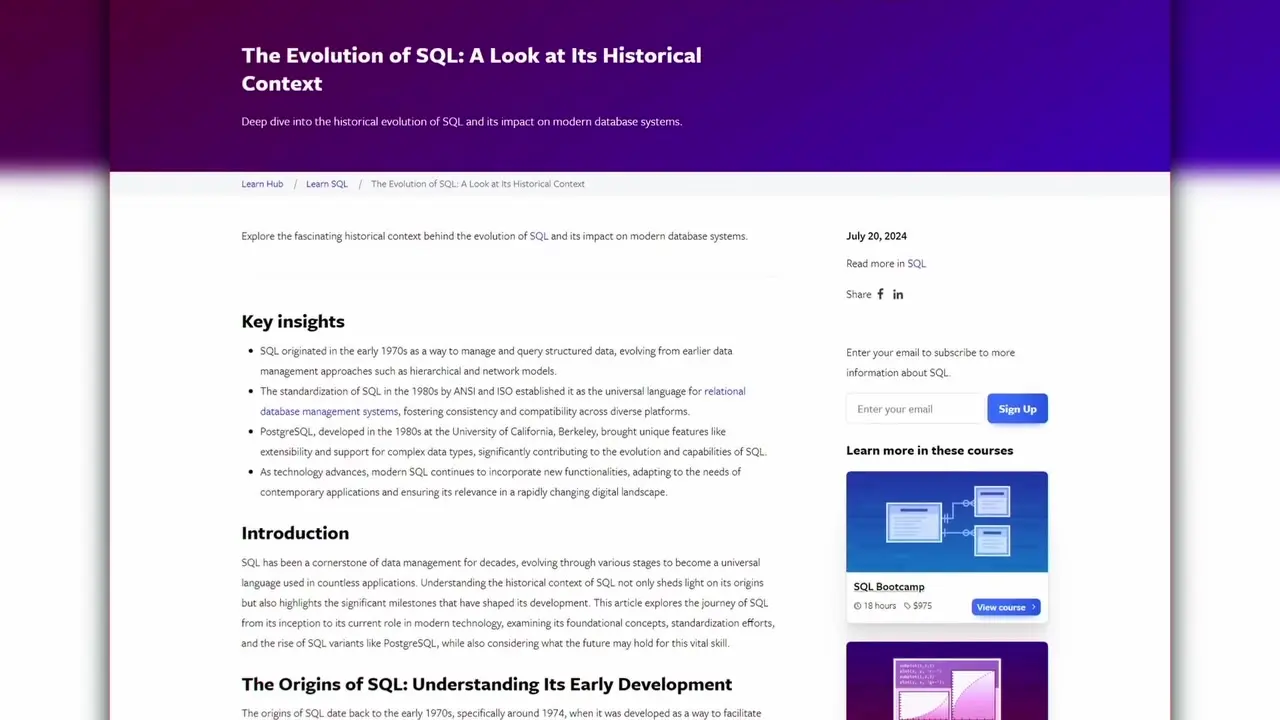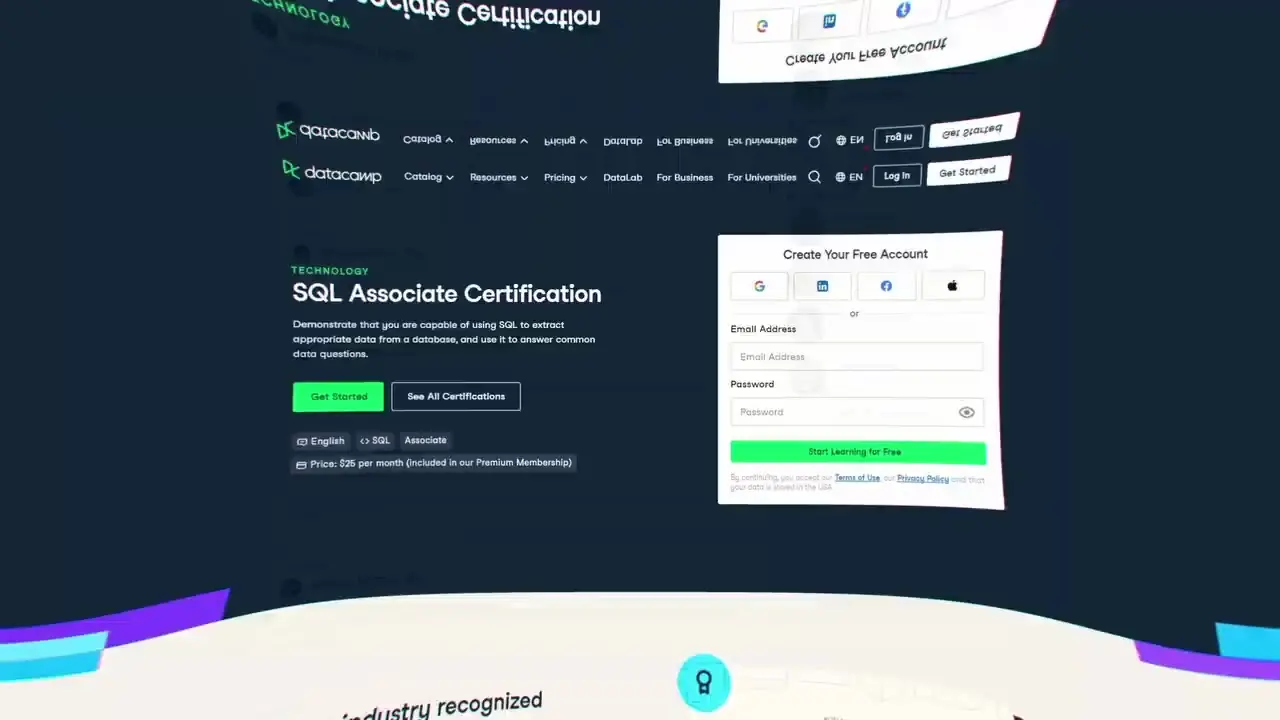
SQL has been around for over 50 years, first appearing in 1974, and remains an essential skill for anyone working with data. Despite its longevity and relatively straightforward syntax, many aspiring data professionals struggle to learn SQL effectively. The reason? Most people lack a clear, structured learning plan and get trapped in an endless loop of tutorials without making real progress.
Why Learn SQL in the First Place?
SQL (Structured Query Language) is used to manage relational databases, which are essentially massive spreadsheets that store data in a structured format with rows and columns. Unlike Excel, where you can modify data by directly clicking on cells, SQL is a query language that communicates with databases indirectly through written instructions.
While this indirect approach might seem more complicated at first, SQL becomes significantly more efficient in the long run because:
- It can handle much larger volumes of data than spreadsheet software
- It enables complex data operations with relatively simple syntax
- It's a universal skill that can help you stand out and secure jobs in data
The 4-Step Strategy to Learn SQL Fast
Step 1: Choose Your Database Management System
The first step in learning SQL is selecting a Database Management System (DBMS). There are four main options: PostgreSQL, MySQL, SQLite, and Microsoft SQL Server. Each has its own dialect of SQL, which can be confusing for beginners.

Why the differences? Back in the 1980s, each vendor created their own version of SQL tailored to their systems. While there's now a standard SQL language, no vendor follows it entirely. Fortunately, the differences between dialects are minimal today, making it relatively easy to switch between them.
According to Stack Overflow's 2024 data on the most popular database technologies:
- PostgreSQL: 48% adoption rate
- MySQL: 40% adoption rate
- SQLite: 33% adoption rate
- Microsoft SQL Server: 25% adoption rate
Recommendation: Start with PostgreSQL due to its popularity and close adherence to standard SQL, or MySQL which is also widely used. The most important thing is to simply choose one and begin learning—you can always switch later.
Step 2: Learn Database Fundamentals (Not Syntax)
A common mistake when learning SQL is studying it like you're preparing for an exam—memorizing syntax and cramming information without practical application. This approach is inefficient and often leads to frustration.
Instead, focus first on understanding database fundamentals and SQL theory, including:
- How databases are structured
- How SQL actually works
- How to properly store data for efficient retrieval while minimizing space
- Basic relational database concepts
You can learn these fundamentals in just a few hours, creating a solid foundation for everything that follows. Think of this as learning the "why" before the "how."
Step 3: Learn Basic SQL Commands
Once you understand the fundamentals, start learning basic SQL commands and how to interact with databases. This is where you'll begin writing and customizing actual queries, such as:
SELECT * FROM table_name WHERE column_name > 5;Focus on these essential SQL operations:
- Querying data from databases (retrieving information)
- Manipulating and editing tables
- Implementing filters to refine results
- Working with multiple tables and joining them together
Don't be afraid to make mistakes during this phase. Experimentation is a crucial part of the learning process and will help you understand SQL's capabilities and limitations.
Step 4: Practice with Real Projects
The single biggest regret among SQL learners is not practicing soon enough or not practicing the right way. Watching tutorials is helpful, but true learning comes from solving problems and working through imperfections.
Effective practice approaches include:
- Starting with your own project idea and figuring things out as you go
- Following guided projects where steps are laid out but you do the actual work
- Using interactive learning platforms that combine instruction with hands-on coding

Interactive learning platforms like DataCamp offer SQL learning paths that cover everything from beginner to advanced concepts in one place. The key advantage is that you're actively coding and working on real projects rather than passively watching tutorials.

For those looking to validate their skills, SQL certification programs test your abilities through timed exams and real-world projects, providing tangible proof of your capabilities to potential employers.
How Do You Know When You've Learned Enough SQL?
One of the most important questions is: when have you learned enough SQL? Without a clear endpoint, you risk getting stuck in an endless learning loop.
The truth is that once you know the fundamentals, you can Google almost anything you don't understand—except during job interviews. For interview preparation and professional competence, focus on mastering these three areas:
1. Database Fundamentals
Understand the theory and how databases work. You don't need to be an expert, but you should comprehend everything covered in a beginner database course.
2. SQL Syntax
While memorizing every command isn't necessary for day-to-day work, interviews often require demonstrating syntax knowledge without reference materials. Focus on common operations from basic SELECT statements to window functions.
3. SQL Application
This is job-specific: can you apply SQL to your particular role? For example, if you're a data analyst, can you independently clean, organize, and analyze data using SQL? This requires combining database fundamentals, SQL syntax, and problem-solving skills specific to your field.
Remember: companies don't care if you know SQL in the abstract—they care that you can use it to solve their specific business problems.
Conclusion
Learning SQL doesn't have to be a months-long struggle. By following this four-step strategy—choosing a DBMS, learning database fundamentals, mastering basic SQL commands, and practicing with real projects—you can learn SQL efficiently and effectively.
The key is to avoid getting stuck in tutorial loops and instead focus on practical application. SQL's relatively straightforward syntax and logical structure make it an accessible skill for most people, provided they approach learning with the right strategy.
Whether you're looking to break into data analysis, enhance your development skills, or simply add another valuable tool to your professional toolkit, this approach will help you learn SQL faster than you might have thought possible.
Let's Watch!
Learn SQL Fast: The Effective 4-Step Strategy for Beginners
Ready to enhance your neural network?
Access our quantum knowledge cores and upgrade your programming abilities.
Initialize Training Sequence